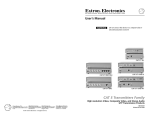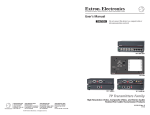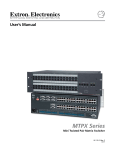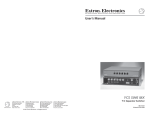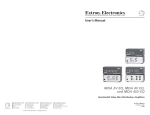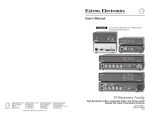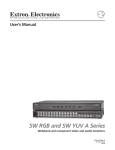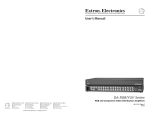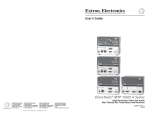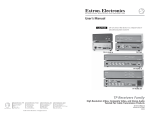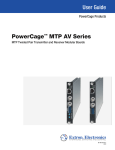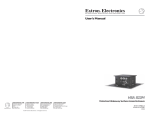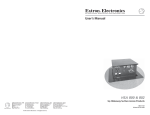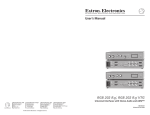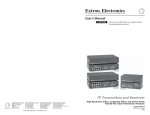Download TP Transmitters cover F.PMD
Transcript
User’s Manual CAUTION Do not connect this device to a computer data or telecommunications network TP Transmitters Family www.extron.com Extron Electronics, USA Extron Electronics, Europe Extron Electronics, Asia Extron Electronics, Japan 1230 South Lewis Street Anaheim, CA 92805 USA 714.491.1500 Fax 714.491.1517 Beeldschermweg 6C 3821 AH Amersfoort The Netherlands +31.33.453.4040 Fax +31.33.453.4050 135 Joo Seng Road, #04-01 PM Industrial Building Singapore 368363 +65.6383.4400 Fax +65.6383.4664 Daisan DMJ Building 6F 3-9-1 Kudan Minami Chiyoda-ku, Tokyo 102-0074 Japan +81.3.3511.7655 Fax +81.3.3511.7656 © 2003 Extron Electronics. All rights reserved. HIgh Resolution Video, Composite Video, and Stereo Audio Twisted Pair Cable Transmission Products 68-546-03 Rev. F Printed in the USA 08 03 Precautions Safety Instructions • English This symbol is intended to alert the user of important operating and maintenance (servicing) instructions in the literature provided with the equipment. This symbol is intended to alert the user of the presence of uninsulated dangerous voltage within the product's enclosure that may present a risk of electric shock. Caution Read Instructions • Read and understand all safety and operating instructions before using the equipment. Retain Instructions • The safety instructions should be kept for future reference. Follow Warnings • Follow all warnings and instructions marked on the equipment or in the user information. Avoid Attachments • Do not use tools or attachments that are not recommended by the equipment manufacturer because they may be hazardous. Consignes de Sécurité • Français Ce symbole sert à avertir l’utilisateur que la documentation fournie avec le matériel contient des instructions importantes concernant l’exploitation et la maintenance (réparation). Ce symbole sert à avertir l’utilisateur de la présence dans le boîtier de l’appareil de tensions dangereuses non isolées posant des risques d’électrocution. Attention Lire les instructions• Prendre connaissance de toutes les consignes de sécurité et d’exploitation avant d’utiliser le matériel. Conserver les instructions• Ranger les consignes de sécurité afin de pouvoir les consulter à l’avenir. Respecter les avertissements • Observer tous les avertissements et consignes marqués sur le matériel ou présentés dans la documentation utilisateur. Eviter les pièces de fixation • Ne pas utiliser de pièces de fixation ni d’outils non recommandés par le fabricant du matériel car cela risquerait de poser certains dangers. Sicherheitsanleitungen • Deutsch Dieses Symbol soll dem Benutzer in der im Lieferumfang enthaltenen Dokumentation besonders wichtige Hinweise zur Bedienung und Wartung (Instandhaltung) geben. Dieses Symbol soll den Benutzer darauf aufmerksam machen, daß im Inneren des Gehäuses dieses Produktes gefährliche Spannungen, die nicht isoliert sind und die einen elektrischen Schock verursachen können, herrschen. Achtung Lesen der Anleitungen • Bevor Sie das Gerät zum ersten Mal verwenden, sollten Sie alle Sicherheits-und Bedienungsanleitungen genau durchlesen und verstehen. Aufbewahren der Anleitungen • Die Hinweise zur elektrischen Sicherheit des Produktes sollten Sie aufbewahren, damit Sie im Bedarfsfall darauf zurückgreifen können. Befolgen der Warnhinweise • Befolgen Sie alle Warnhinweise und Anleitungen auf dem Gerät oder in der Benutzerdokumentation. Keine Zusatzgeräte • Verwenden Sie keine Werkzeuge oder Zusatzgeräte, die nicht ausdrücklich vom Hersteller empfohlen wurden, da diese eine Gefahrenquelle darstellen können. Instrucciones de seguridad • Español Este símbolo se utiliza para advertir al usuario sobre instrucciones importantes de operación y mantenimiento (o cambio de partes) que se desean destacar en el contenido de la documentación suministrada con los equipos. Este símbolo se utiliza para advertir al usuario sobre la presencia de elementos con voltaje peligroso sin protección aislante, que puedan encontrarse dentro de la caja o alojamiento del producto, y que puedan representar riesgo de electrocución. Precaucion Leer las instrucciones • Leer y analizar todas las instrucciones de operación y seguridad, antes de usar el equipo. Conservar las instrucciones • Conservar las instrucciones de seguridad para futura consulta. Obedecer las advertencias • Todas las advertencias e instrucciones marcadas en el equipo o en la documentación del usuario, deben ser obedecidas. Evitar el uso de accesorios • No usar herramientas o accesorios que no sean especificamente recomendados por el fabricante, ya que podrian implicar riesgos. FCC Class A Notice Warning Power sources • This equipment should be operated only from the power source indicated on the product. This equipment is intended to be used with a main power system with a grounded (neutral) conductor. The third (grounding) pin is a safety feature, do not attempt to bypass or disable it. Power disconnection • To remove power from the equipment safely, remove all power cords from the rear of the equipment, or the desktop power module (if detachable), or from the power source receptacle (wall plug). Power cord protection • Power cords should be routed so that they are not likely to be stepped on or pinched by items placed upon or against them. Servicing • Refer all servicing to qualified service personnel. There are no userserviceable parts inside. To prevent the risk of shock, do not attempt to service this equipment yourself because opening or removing covers may expose you to dangerous voltage or other hazards. Slots and openings • If the equipment has slots or holes in the enclosure, these are provided to prevent overheating of sensitive components inside. These openings must never be blocked by other objects. Lithium battery • There is a danger of explosion if battery is incorrectly replaced. Replace it only with the same or equivalent type recommended by the manufacturer. Dispose of used batteries according to the manufacturer's instructions. Note: This equipment has been tested and found to comply with the limits for a Class A digital device, pursuant to part 15 of the FCC Rules. These limits are designed to provide reasonable protection against harmful interference when the equipment is operated in a commercial environment. This equipment generates, uses and can radiate radio frequency energy and, if not installed and used in accordance with the instruction manual, may cause harmful interference to radio communications. Operation of this equipment in a residential area is likely to cause harmful interference, in which case the user will be required to correct the interference at his own expense. Note: This unit was tested with shielded cables on the peripheral devices. Shielded cables must be used with the unit to ensure compliance. Avertissement Alimentations• Ne faire fonctionner ce matériel qu’avec la source d’alimentation indiquée sur l’appareil. Ce matériel doit être utilisé avec une alimentation principale comportant un fil de terre (neutre). Le troisième contact (de mise à la terre) constitue un dispositif de sécurité : n’essayez pas de la contourner ni de la désactiver. Déconnexion de l’alimentation• Pour mettre le matériel hors tension sans danger, déconnectez tous les cordons d’alimentation de l’arrière de l’appareil ou du module d’alimentation de bureau (s’il est amovible) ou encore de la prise secteur. Protection du cordon d’alimentation • Acheminer les cordons d’alimentation de manière à ce que personne ne risque de marcher dessus et à ce qu’ils ne soient pas écrasés ou pincés par des objets. Réparation-maintenance • Faire exécuter toutes les interventions de réparationmaintenance par un technicien qualifié. Aucun des éléments internes ne peut être réparé par l’utilisateur. Afin d’éviter tout danger d’électrocution, l’utilisateur ne doit pas essayer de procéder lui-même à ces opérations car l’ouverture ou le retrait des couvercles risquent de l’exposer à de hautes tensions et autres dangers. Fentes et orifices • Si le boîtier de l’appareil comporte des fentes ou des orifices, ceux-ci servent à empêcher les composants internes sensibles de surchauffer. Ces ouvertures ne doivent jamais être bloquées par des objets. Lithium Batterie • Il a danger d'explosion s'll y a remplacment incorrect de la batterie. Remplacer uniquement avec une batterie du meme type ou d'un ype equivalent recommande par le constructeur. Mettre au reut les batteries usagees conformement aux instructions du fabricant. Vorsicht Stromquellen • Dieses Gerät sollte nur über die auf dem Produkt angegebene Stromquelle betrieben werden. Dieses Gerät wurde für eine Verwendung mit einer Hauptstromleitung mit einem geerdeten (neutralen) Leiter konzipiert. Der dritte Kontakt ist für einen Erdanschluß, und stellt eine Sicherheitsfunktion dar. Diese sollte nicht umgangen oder außer Betrieb gesetzt werden. Stromunterbrechung • Um das Gerät auf sichere Weise vom Netz zu trennen, sollten Sie alle Netzkabel aus der Rückseite des Gerätes, aus der externen Stomversorgung (falls dies möglich ist) oder aus der Wandsteckdose ziehen. Schutz des Netzkabels • Netzkabel sollten stets so verlegt werden, daß sie nicht im Weg liegen und niemand darauf treten kann oder Objekte darauf- oder unmittelbar dagegengestellt werden können. Wartung • Alle Wartungsmaßnahmen sollten nur von qualifiziertem Servicepersonal durchgeführt werden. Die internen Komponenten des Gerätes sind wartungsfrei. Zur Vermeidung eines elektrischen Schocks versuchen Sie in keinem Fall, dieses Gerät selbst öffnen, da beim Entfernen der Abdeckungen die Gefahr eines elektrischen Schlags und/oder andere Gefahren bestehen. Schlitze und Öffnungen • Wenn das Gerät Schlitze oder Löcher im Gehäuse aufweist, dienen diese zur Vermeidung einer Überhitzung der empfindlichen Teile im Inneren. Diese Öffnungen dürfen niemals von anderen Objekten blockiert werden. Litium-Batterie • Explosionsgefahr, falls die Batterie nicht richtig ersetzt wird. Ersetzen Sie verbrauchte Batterien nur durch den gleichen oder einen vergleichbaren Batterietyp, der auch vom Hersteller empfohlen wird. Entsorgen Sie verbrauchte Batterien bitte gemäß den Herstelleranweisungen. Advertencia Alimentación eléctrica • Este equipo debe conectarse únicamente a la fuente/tipo de alimentación eléctrica indicada en el mismo. La alimentación eléctrica de este equipo debe provenir de un sistema de distribución general con conductor neutro a tierra. La tercera pata (puesta a tierra) es una medida de seguridad, no puentearia ni eliminaria. Desconexión de alimentación eléctrica • Para desconectar con seguridad la acometida de alimentación eléctrica al equipo, desenchufar todos los cables de alimentación en el panel trasero del equipo, o desenchufar el módulo de alimentación (si fuera independiente), o desenchufar el cable del receptáculo de la pared. Protección del cables de alimentación • Los cables de alimentación eléctrica se deben instalar en lugares donde no sean pisados ni apretados por objetos que se puedan apoyar sobre ellos. Reparaciones/mantenimiento • Solicitar siempre los servicios técnicos de personal calificado. En el interior no hay partes a las que el usuario deba acceder. Para evitar riesgo de electrocución, no intentar personalmente la reparación/ mantenimiento de este equipo, ya que al abrir o extraer las tapas puede quedar expuesto a voltajes peligrosos u otros riesgos. Ranuras y aberturas • Si el equipo posee ranuras o orificios en su caja/alojamiento, es para evitar el sobrecalientamiento de componentes internos sensibles. Estas aberturas nunca se deben obstruir con otros objetos. Batería de litio • Existe riesgo de explosión si esta batería se coloca en la posición incorrecta. Cambiar esta batería únicamente con el mismo tipo (o su equivalente) recomendado por el fabricante. Desachar las baterías usadas siguiendo las instrucciones del fabricante. Extron’s Warranty Extron Electronics warrants this product against defects in materials and workmanship for a period of three years from the date of purchase. In the event of malfunction during the warranty period attributable directly to faulty workmanship and/or materials, Extron Electronics will, at its option, repair or replace said products or components, to whatever extent it shall deem necessary to restore said product to proper operating condition, provided that it is returned within the warranty period, with proof of purchase and description of malfunction to: USA, Canada, South America, and Central America: Extron Electronics 1230 South Lewis Street Anaheim, CA 92805, USA Asia: Extron Electronics, Asia 135 Joo Seng Road, #04-01 PM Industrial Bldg. Singapore 368363 Europe, Africa, and the Middle East: Extron Electronics, Europe Beeldschermweg 6C 3821 AH Amersfoort The Netherlands Japan: Extron Electronics, Japan Daisan DMJ Bldg. 6F, 3-9-1 Kudan Minami Chiyoda-ku, Tokyo 102-0074 Japan This Limited Warranty does not apply if the fault has been caused by misuse, improper handling care, electrical or mechanical abuse, abnormal operating conditions or non-Extron authorized modification to the product. If it has been determined that the product is defective, please call Extron and ask for an Applications Engineer at (714) 491-1500 (USA), 31.33.453.4040 (Europe), 65.6383.4400 (Asia), or 81.3.3511.7655 (Japan) to receive an RA# (Return Authorization number). This will begin the repair process as quickly as possible. Units must be returned insured, with shipping charges prepaid. If not insured, you assume the risk of loss or damage during shipment. Returned units must include the serial number and a description of the problem, as well as the name of the person to contact in case there are any questions. Extron Electronics makes no further warranties either expressed or implied with respect to the product and its quality, performance, merchantability, or fitness for any particular use. In no event will Extron Electronics be liable for direct, indirect, or consequential damages resulting from any defect in this product even if Extron Electronics has been advised of such damage. Please note that laws vary from state to state and country to country, and that some provisions of this warranty may not apply to you. Table of Contents Chapter 1 • Introduction ....................................................... 1-1 About the TP Transmitters ............................................. 1-2 Features ................................................................................. 1-3 TP T 15HD A transmitter ....................................................... 1-3 TP T 15HD AV transmitter ..................................................... 1-4 TP T 460/468 transmitters ...................................................... 1-5 TP T 460 Dual transmitters .................................................... 1-5 TP T AV transmitter ............................................................... 1-6 TP T BNC transmitter ............................................................. 1-6 TP T BNC DA4 transmitter/distribution amplifier ................ 1-6 Chapter 2 • Installation and Operation ......................... 2-1 Installation Overview .......................................................... 2-2 Video jumpers ........................................................................ 2-4 Video DIP switch .................................................................... 2-5 Audio jumpers ....................................................................... 2-5 Grounding the transmitter ................................................... 2-7 Input cabling .......................................................................... 2-8 Computer video and PC audio ........................................... 2-8 Composite video and stereo audio .................................. 2-12 RGBHV video ................................................................... 2-12 Transmitted signal cabling .................................................. 2-13 Termination of TP cable ................................................... 2-14 Cable testing ................................................................... 2-14 Equalizing pair skew ........................................................ 2-15 Power connector .................................................................. 2-16 Unique TP T 460/468 front panel features ......................... 2-17 Front Panel Control and Indicators ............................ 2-18 Troubleshooting ................................................................... 2-19 If the image does not appear ............................................. 2-19 If the image is not displayed correctly ............................... 2-20 If the receiver’s Manual/Auto LED flashes .......................... 2-20 Appendix A • TP T 460/468 Installation ......................... A-1 TP T 460/468 Installation Overview ............................. A-2 UL Requirements for Wall Box Installation ............ A-3 TP Transmitters • Table of Contents i Table of Contents, cont’d Euro Channel Models .......................................................... A-4 Installation Procedures ...................................................... A-4 Preparing the site, installing the mud ring or wall box ..... A-4 Mounting the AAP devices (TP T 468 only) ......................... A-8 Mounting the transmitter to the mud ring or wall box .... A-9 Euro Channel transmitter installation ............................... A-10 Appendix B • Specifications, Accessories, Part Numbers, and Templates .............................................. B-1 Specifications .......................................................................... B-2 Included Parts .......................................................................... B-6 Accessories ................................................................................ B-7 Cables/Adapters ..................................................................... B-8 Optional Adapter Plates .................................................... B-9 Single type connector architectural adapter plates .......... B-10 Multi type connector architectural adapter plates ........... B-12 Templates ................................................................................. B-13 TP T 460 cut-out template ................................................... B-14 TP T 468 cut-out template ................................................... B-15 TP Transmitters 1 Chapter One Introduction About the TP Transmitters Features 68-546-03 Rev. F Printed in the USA 08 03 ii TP Transmitters • Table of Contents Introduction, cont’d Introduction About the TP Transmitters Extron’s Twisted Pair (TP) transmitters provide long-distance distribution of RGB video, component video, S-video, composite video, and stereo audio over Extron’s Skew-Free™ A/V UTP cable or standard Category (CAT) 5 unshielded twisted pair (UTP), shielded twisted pair (STP), or foil shielded twisted pair (FTP) cable. The minimum reliable transmission distance to all receivers, with the exception of the TP R 15HD A, is 50 feet. There is no minimum distance for transmission to the TP R 15HD A. The maximum distance is determined by the output frequency and resolution. The following table specifies the recommended maximum transmission distances using Extron Skew-Free A/V UTP cable or UTP CAT 5 cable, terminated with CAT 6, or at least CAT 5e, rated connectors. Extron recommends using the highest quality cable available and affordable. We also recommend the use of pre-terminated and tested cables. Cables terminated on site should be tested before use to ensure that they comply with Category 5e specifications. Recommended transmission ranges at 60 Hz to TP R 15HD A Video format Maximum range Composite video and audio 800 feet Component video and S-video 800 feet 640 x 480 500 feet 800 x 600 400 feet 1024 x 768 300 feet 1280 x 1024 200 feet 1600 x 1280 100 feet Recommended transmission ranges at 60 Hz to all other receivers Video format Maximum range Composite video and audio 1000 feet Component video and S-video 1000 feet 640 x 480 1000 feet 800 x 600 800 feet 1024 x 768 600 feet 1280 x 1024 400 feet 1600 x 1280 200 feet It is possible to exceed the recommended distances, however, image quality may be reduced. 1-2 TP Transmitters • Introduction Each transmitted TP signal must be connected to the appropriate Extron TP receiver. This user’s manual documents the installation, features, and operation of the TP transmitters only. For information about the TP receivers, refer to the TP Receivers Family User’s Manual, which accompanies the receivers. The TP T 460 is mountable in a 2-gang mud ring or electrical box installed in a wall or inset in furniture. The TP T 460 Dual and TP T 468 are mountable in a 4-gang mud ring or wallbox. The TP T 460 and TP T 468 are also available in Euro Channel (EC) versions (see appendix B for part numbers). The TP T 460, TP T 460 Dual, and TP T 468 are functionally identical to each other, with the following exceptions: • The TP T 460 Dual consists of the circuitry of two separate TP T 460 transmitters mounted on a single 4-gang faceplate. The inputs and outputs are completely separate. There are no switching or signal splitting functions associated with the Dual. • The TP T 468 has openings for four single space (single height) Extron Architectural Adapter Plates (AAPs). Because of the similarity of these products, they will be discussed together, as the TP T 460/468, unless differences exist. Features All Extron TP transmitters provide the following features: Frequency range — Supports 15 kHz to 130 kHz horizontal frequency. TP T 15HD A transmitter Video input — Accepts computer analog video on a 15-pin HD female connector. With an adapter cable, the transmitter can accept Macintosh, 13W3 video, RGBHV, RGBS, RGsB, component video, S-video, or single source composite video input. Buffered local monitor output — Allows you to view the displayed image on a local monitor that is located up to 100 feet from the transmitter, without signal reflections or crosstalk. Audio input — Accepts PC audio on a 3.5 mm stereo mini jack. RJ-45 connector — Provides a connection to an Extron TP RGB video receiver. TP Transmitters • Introduction 1-3 Introduction, cont’d Horizontal shift — Allows you to adjust the horizontal placement of the image on the screen. Also called “horizontal centering”. Mounting — Can be rack mounted with Extron’s TP Rack Mounting Kit (part #70-123-01) and 1U rack shelf (part #60-190-01) or 1U Basic Rack Shelf (part #60-604-01), or it can be furniture mounted with Extron’s Under Desk Mounting Kit (part #70-077-01) or Through Desk Mounting Kit (part #70-077-02). TP T 15HD AV transmitter Video input Computer video — Accepts computer analog video on a 15-pin HD female connector. With an adapter cable, the 15HD connector can accept a Macintosh video, 13W3 video, or RGBHV, RGBS, RGsB, component video, S-video, or single source composite video input. Composite video — Accepts NTSC, PAL, and SECAM composite video on an RCA jack. Alternately, the composite video channel can support digital audio. Buffered local monitor output — Allows you to view the displayed computer video image on a local monitor that is located up to 100 feet from the transmitter, without signal reflections or crosstalk. Audio input — Accepts PC audio on a 3.5 mm stereo mini jack, and stereo audio on two RCA jacks. RJ-45 connectors — One connector provides a connection to an Extron TP RGB video receiver, and the other provides a connection to a TP composite video receiver. Horizontal shift — Allows you to adjust the horizontal placement of the computer video image on the screen. Mounting — Can be rack mounted with Extron’s TP Rack Mounting Kit (part #70-123-01) and 1U rack shelf (part #60-190-01) or 1U Basic Rack Shelf (part #60-604-01), or it can be furniture mounted with Extron’s Under Desk Mounting Kit (part #70-077-01) or Through Desk Mounting Kit (part #70-077-02). 1-4 TP Transmitters • Introduction TP T 460/468 transmitters Video input — Accepts computer analog video on a 15-pin HD female connector. With an adapter cable, the transmitter can accept a Macintosh, 13W3 , RGBHV, RGBS, RGsB, component video, S-video, or composite video input. Buffered local monitor output — Allows you to view the displayed image on a local monitor that is located up to 100 feet from the transmitter, without signal reflections or crosstalk. Audio input — Accepts PC stereo audio on a 3.5 mm stereo mini jack. RJ-45 connector — Provides a connection to an Extron TP RGB video receiver. Horizontal shift — Allows you to adjust the horizontal placement of the computer video image on the screen. Choice of colors — The TP T 460/468 transmitters are available with a choice of gray, black, or white front panels to match any decor. Mounting — Wall or furniture mounted in a two-gang (TP T 460) or four-gang (TP T 468) wall box. EC versions are available that are mountable in a Euro Channel raceway. Adapter plate capable (TP T 468 only) — The TP T 468 has openings for four single space (single-height) Extron AAPs with pass-through connectors. TP T 460 Dual transmitters Video inputs — Accept two separate computer analog video inputs on two independent 15-pin HD female connectors. With adapter cables, the transmitter can accept Macintosh, 13W3, RGBHV, RGBS, RGsB, component video, S-video, or composite video inputs. Buffered local monitor outputs — Allow you to view the displayed images on local monitors located up to 100 feet from the transmitters, without signal reflections or crosstalk. Audio inputs — Accepts two independent PC stereo audio inputs on separate 3.5 mm stereo mini jacks. RJ-45 connectors — Provide connections to two Extron TP RGB video receivers. Each RJ-45 connector carries one of the two computer video and audio inputs. Mounting — The Dual can be wall or furniture mounted in a four-gang wall box. TP Transmitters • Introduction 1-5 Introduction, cont’d TP T AV transmitter Video input — Accepts NTSC, PAL, and SECAM composite video on an RCA jack. Alternately, the composite video channel can support digital audio. TP Transmitters Audio input — Accepts stereo audio on two RCA jacks. RJ-45 connector — Allows connection to an Extron TP composite video receiver. Mounting — Can be furniture mounted with Extron’s Under Desk Mounting Kit (part #70-077-01) or Through Desk Mounting Kit (part #70-077-02). TP T BNC transmitter Video input — Accepts RGBHV, RGBS, RGsB, component video, and composite video on BNC connectors. With an adapter cable, the transmitter can also accept an S-video input. RJ-45 connector — Allows connection to an Extron TP RGB video receiver. Mounting — Can be rack mounted with Extron’s TP Rack Mounting Kit (part #70-123-01) and 1U rack shelf (60-190-01) or 1U Basic Rack Shelf (part #60-604-01), or it can be furniture mounted with Extron’s Under Desk Mounting Kit (part #70-077-01) or Through Desk Mounting Kit (part #70-077-02). TP T BNC DA4 transmitter/distribution amplifier Video input — Accepts RGBHV, RGBS, RGsB, component video, and composite video on BNC connectors. With an adapter cable, the transmitter can also accept an S-video input. RJ-45 connectors — Allows connection to up to four Extron TP RGB video receivers. Mounting — Can be rack mounted with Extron’s TP Rack Mounting Kit (part #70-123-01) and 1U rack shelf (part #60-190-01) or 1U Basic Rack Shelf (part #60-604-01), or it can be furniture mounted with Extron’s Under Desk Mounting Kit (part #70-077-01) or Through Desk Mounting Kit (part #70-077-02). 1-6 TP Transmitters • Introduction 2 Chapter Two Installation and Operation Installation Overview Front Panel Control and Indicators Troubleshooting Installation and Operation, Operation cont’d CAUTION Installation and service must be performed by authorized personnel only. The TP T 460/468 must be used with UL approved electrical boxes. 8 All TP transmitters include a 15V external power supply. The transmitters also receive power from the associated Extron TP receiver(s) (with the exception of the TP R 15HD A) via the TP cable. Extron recommends using the local power supply; however, the power supply may not be necessary in some applications. Use the following guidelines: Installation Overview To install and set up a TP transmitter and the associated TP receiver(s) for operation, perform the following steps: 1 Disconnect power from all of the equipment, including the video source(s) (such as computers or DVD players), the transmitter, the receiver, and the output display(s). 2 For component, S-video, or composite video, reconfigure the jumpers (TP T 15HD A, TP T 15HD AV, TP T BNC, and TP T BNC DA4) or DIP switch (TP T 460/468). See Video jumpers or Video DIP switch in this chapter. 3 TP T 15HD AV and TP T AV only — If desired, configure the audio jumpers to make the transmitter compatible with unmodified TP receivers. See Audio jumpers in this chapter. The TP T AV and TP T 15HD AV are redesigned (modified) transmitters. The audio jumpers configure the audio portion of the composite video TP link to work with either similarly redesigned TP R AV and TP R BNC AV receivers or with older, unmodified receivers. Redesigned transmitters and receivers have an identifying label. 2-2 4 Mount the transmitter in a rack, under a desk or podium, in a desk or table, or in a wall. For rack or furniture mounting, refer to the instructions that accompanied the mounting kit for specific information. For the TP T 460/ 468, see Appendix A, TP T 460/468 Installation. 5 Connect the input cables. See Input cabling in this chapter. 6 Connect the cable(s) between the transmitter and the TP receiver(s). See Transmitted signal cabling in this chapter and refer to the TP Receivers Family User’s Manual, part #68-547-01. 7 Configure the TP receiver(s). Refer to the TP Receivers Family User’s Manual, part #68-547-01. TP Transmitters • Installation and Operation Connect power cords to the TP receiver, the TP transmitter, and turn on the video source(s) and the output display(s). • The TP T 15HD A, TP T 460/468, TP T 15HD AV, and TP T BNC may not require a local power supply for cable lengths of 300 feet or less. • The TP T AV may not require a local power supply for cable lengths of 800 feet or less. • The TP T BNC DA4 and any transmitter connected to a TP R 15HD A always require the local power supply. If problems are encountered, use the local power supply. 9 Adjust the picture controls on the front panel of the transmitter and receiver(s). See Front Panel Control and Indicator in this chapter and refer to the TP Receivers Family User’s Manual, part #68-547-01. 10 For the TP T 460/468 only — Disconnect power from all the devices. 11 For the TP T 460/468 only — Mount the transmitter into the mud ring or electrical box. See Mounting the AAP devices (TP T 468 only) and Mounting the transmitter to the mud ring or wall box or Euro Channel transmitter installation in appendix A, TP T 460/468 Installation. 12 For the TP T 460/468 only — Restore power to the devices. TP Transmitters • Installation and Operation 2-3 Installation and Operation, cont’d Video jumpers TP T 15HD A and TP T 15HD AV — Locate J1 and J2 on the printed circuit board. See figure 2-1. 4. The TP T 15HD A, TP T 15HD AV, TP T BNC, and TP T BNC DA4 can be configured to transmit component video, S-video, or composite video. The transmitters are factory configured for RGB video. For any other type of video, reconfigure the jumpers. 1. (TP T BNC & TP T BNC DA4) Remove 5 BNC Hex Nuts Remove 6 Screws DIO CO MP UT 1 1 INPU BU 1 1 LO CA FF ER L MO ED HNITO SH IFT R TP T 1 1 1 1 Component, S-video, Composite Component, S-video, RGB Composite ER T ID PIN 4 ID PIN 11 AU Lift Cover Straight Up 15 HD A RGB 1 1 1 1 1 1 1 b. For any other video format, ensure that pin 1 is jumpered to pin 2 on both jumper locations. a. For RGB video, ensure that pin 2 is jumpered to pin 3 on both jumper locations. b. For any other video format, ensure that pin 1 is jumpered to pin 2 on both jumper locations. Replace the cover and reinstall the screws. 5. Video DIP switch The TP T 460/468 can be configured to transmit component video, S-video, or composite video. To configure the TP T 460/468 for RGB video, set DIP switch 2 on the back of the transmitter to off. For any other video format set the switch on. For the TP T 460 Dual, set the DIP switches on the back of both transmitters to the desired positions. O N 12 J1 J2 1 For RGB video, ensure that pin 2 is jumpered to pin 3 on both jumper locations. TP T BNC and TP T BNC DA4 — Locate J11 and J12 on the printed circuit board. See figure 2-1. Remove the two screws on each side and the screw on top of the cover (figure 2-1). TP T 15HD A a. J12 J11 U31 Audio jumpers TP T BNC and TP T BNC DA4 TP T 15HD A and TP T 15HD AV Figure 2-1 — Video jumper configuration 2. TP T BNC and TP T BNC DA4 — Using an Extron BNC extraction tool (part #100-096-01) or a 14 mm, deep well socket with thin walls, remove the five hex nuts securing the BNC connectors to the rear panel. Slide the cover forward until the cover clears the BNC connectors 3. Lift the cover off. Older (unmodified) transmitters and receivers are fully compatible with each other but not with the TPX 88 A twisted pair matrix switcher. Redesigned (modified) transmitters and receivers are fully compatible with each other and with the TPX 88 A. They can also be jumpered to be compatible with the older (unmodified) receivers and transmitters but not the TPX 88 A. Redesigned (modified) transmitters and receivers have an identifying label. The audio that is associated with the composite video link of TP T 15HD AV and TP T AV transmitters is transmitted on wire pair 3 and 6. This configuration is compatible with redesigned TP receivers and the TPX 88 A. If you intend to match this transmitter with an older, unmodified TP receiver, and do not plan to include a TPX 88 A in your system, you can set the transmitter to send the audio on wire pair 7 and 8, to be compatible with an older TP receiver, by shifting internal jumpers as follows: 2-4 TP Transmitters • Installation and Operation TP Transmitters • Installation and Operation 2-5 Installation and Operation, cont’d Remove the two screws on each side and the screw on top of the cover (figure 2-2). 1. Remove (5) Screws AU DI TP T 15HD AV Lift Cover straight up O CO MP IN UT PU ER ID PIN Grounding the transmitter RGB and computer video transmitters may need to be grounded to ensure that the video and audio are not degraded. The TP T 15HD A, TP T 15HD AV, TP T BNC, and TP T 460/468 may require grounding if all of the following conditions are true: • The signal source is a laptop computer. • No local monitor is connected. • A local power supply is not being used. 4 ID PIN T 11 BU LO CA FF ER L MO ED NI TO R H- PC SH IFT VIDE O AU DI O T1 R 5H D AV The TP T 460/468, when properly installed in a UL approved electrical box, and installed with conduit in accordance with the National Electrical Code, should not require further grounding. 1 Wire Pair Wire Pair 3&6* 7&8 L TP 1 Wire Pair Wire Pair 3&6* 7&8 1 1 J10 J11 J6 J7 Grounding may also be required if there is no common ground in the power distribution system. Indications that grounding may be required include: TP T AV TP T 15HD AV • The receiver’s Power LED is lit amber when a connection is made to the transmitter. • The receiver is in auto mode and its Manual/Auto LED flashes. • The receiver is in manual mode and an image appears only when the Peaking adjustment is at the minimum level. Additionally, the image may be overpeaked with horizontal streaking to the right of displayed information. • No audio, or distorted and noisy audio, is heard. * TPX compatible Figure 2-2 — Audio jumper configuration 2. Lift the cover off. 3. TP T AV — Locate J10 and J11 on the printed circuit board. See figure 2-2 a. b. For compatibility with redesigned (modified) receivers and the TPX 88 A, ensure that pin 1 is jumpered to pin 2 on both jumper locations. For compatibility with older (unmodified) receivers, ensure that pin 2 is jumpered to pin 3 on both jumper locations. Ground the transmitter using any of the following methods: • Connect a local 15V power supply to the transmitter. • Use STP rather than UTP cable and connectors. • TP T 15 HD A, TP T 15HD AV, and TP T BNC only — Use a 3.5 mm captive screw connector to connect a ground wire between the power return pin (figure 2-3) and a grounding point near the transmitter, such as a grounded power outlet or an equipment rack. TP T 15HD AV — Locate J6 and J7 on the printed circuit board. See figure 2-2 4. a. For compatibility with redesigned (modified) receivers and the TPX 88 A, ensure that pin 1 is jumpered to pin 2 on both jumper locations. TP T 15HD A, TP T 15HD AV, TP T BNC b. For compatibility with older (unmodified) receivers, ensure that pin 2 is jumpered to pin 3 on both jumper locations. N/C Replace the cover and reinstall the screws. TP T 460/468 Return Grounding point near transmitter Figure 2-3 — Grounding the transmitter 2-6 TP Transmitters • Installation and Operation TP Transmitters • Installation and Operation 2-7 Installation and Operation, cont’d • TP T 460/468 only — Connect a ground wire between the power return pin (figure 2-3) of the 3.5 mm, 2-pole directinsertion captive screw connector on the rear of the transmitter and a grounding point near the transmitter. • TP T 460 Dual only — The two transmitters of the TP T 460 Dual share a common ground; if grounding is required, you can ground only one of the transmitters. 13 MONITOR H. SHIFT 3 INPUT MIN/MAX NO MONITOR 4 Input cabling MONITOR AUDIO Computer video and PC audio The TP T 15HD A (figure 2-4), TP T 15HD AV (figure 2-5), TP T 460/468 (figure 2-6), and the TP T 460 Dual (figure 2-7, page 2-10) all accept and transmit computer video and PC audio. These transmitters can also accommodate component video, S-video, or composite video if input on the R, G, and B pins of the 15HD connector using an Extron SY15 HDM-RGBHV F 6” cable, part #26-531-01. 2 AUDIO 1 COMPUTER 4 ID PIN 4 2 1 14 5 6 3 ID PIN 11 INPUT TP T 468 BUFFERED H-SHIFT LOCAL MONITOR TP T 15HD A 12 5 DDSP SPARE 10 POWER 15V .5A DC OUTPUT 12 Figure 2-4 — Installation features, TP T 15HD A 10 Figure 2-6 — Installation features, TP T 468 2 AUDIO 1 COMPUTER 4 ID PIN 4 3 ID PIN 11 PC H-SHIFT BUFFERED 7 8 VIDEO AUDIO L INPUT R LOCAL MONITOR TP T 15HD AV 11 5 10 DDSP SPARE 12 Transmission of component video, S-video, or composite video on the computer video input requires that internal jumpers (TP T 15HD A and TP T 15HD AV) or a DIP switch (TP T 460/468) be reconfigured. See Video jumpers or Video DIP switch in this chapter. POWER 15V .5A DC AV COMPUTER OUTPUTS Figure 2-5 — Installation features, TP T 15HD AV 2-8 TP Transmitters • Installation and Operation TP Transmitters • Installation and Operation 2-9 Installation and Operation, cont’d 2 13 MONITOR H. SHIFT MONITOR Input only analog, line level, audio signals on the audio input connector. 13 H. SHIFT 3 Tip (L) Ring (R) 3 INPUT NO MONITOR INPUT MIN/MAX Audio input connector — Connect PC audio to this 3.5 mm, stereo jack. Wire the male plug as shown in figure 2-8. MIN/MAX NO MONITOR 4 MONITOR MONITOR AUDIO AUDIO Sleeve ( ) Figure 2-8 — Audio input wiring TP T 460 DUAL 2 1 4 2 1 3 Buffered Local Monitor output connector — Connect a local monitor video cable to this 15-pin HD female connector. 4 ID bit switches (TP T 15HD A and TP T 15HD AV) — If a local monitor is installed, set both switches to off. If no local monitor is installed, set both switches to on. Monitor/No Monitor switch (TP T 460/468) — If a local monitor is installed, set the switch to Monitor. If no local monitor is installed, set the switch to No Monitor. 6 5 5 DDSP switch — This switch turns on Digital Display Sync Processing, disabling sync processing for LCD projectors and other displays that cannot tolerate processed sync. DDSP disables the horizontal shift control. 6 12 10 5 12 6 10 Figure 2-7 — Installation features, TP T 460 Dual 1 Computer Input connector — Connect computer video to this 15-pin HD female connector. 10 5 15 1 RGB/video switch (TP T 460/468 only) — Configures the transmitter for RGB or component/S-video/composite video. See Video DIP switch in this chapter. 6 11 Input only sync signals, no video signals, Female on the sync pins, 13 and 14. For component video, use the R (R-Y) and R return pins (pins 1 and 6), G (Y) and G return pins (pins 2 and 7), and B (B-Y) and B return pins (pins 3 and 8). For S-video, use the R, R return (C-chroma), G, and G return (Y-luma) pins. For composite video, use the G pin and the associated return pin. For additional genlocked video signals, use the R, B, and associated return pins. 2-10 TP Transmitters • Installation and Operation TP Transmitters • Installation and Operation 2-11 Installation and Operation, cont’d Composite video and stereo audio 9 The TP T 15HD AV (figure 2-5) and the TP T AV (figure 2-9) both accept and transmit composite video and stereo audio. 7 8 VIDEO AUDIO L Input only sync signals (no video signals) on the H/V and V BNCs. R For RGBHV video, use the R, G, B, H/HV, and V BNCs. TP T AV 12 Video connector — Connect the desired video input device to the rear panel input BNCs. Transmission of component video, S-video, or composite video requires that internal jumpers be reconfigured. See Video jumpers in this chapter. R G B H/HV V 11 For RGBS video, use the R, G, B, and H/HV BNCs. AV OUTPUT R POWER G B H/HV V 15V .5A DC For component video, use the R (R-Y), G (Y), and B (B-Y) BNCs. Figure 2-9 — Installation features, TP T AV R 7 8 Video connector — Connect composite video to this RCA connector. Digital audio can also be connected to this connector. R Input only analog, line level audio signals on these connectors. The TP T BNC (figure 2-10) and the TP T BNC DA4 (figure 2-11) both accept and transmit RGBHV, RGBS, RGsB, component video, S-video, and composite video. R G H/HV V POWER OUTPUT 9 R G B H/HV 10 10 OUTPUT 1 OUTPUT 2 10 B H/HV V R G -or- -or- B H/HV V Do not connect this device to a computer data or telecommunications network RJ-45 termination must comply with the TIA/EIA T 568A wiring standards for all connections. Figure 2-10 — Installation features, TP T BNC 12 G CAUTION 15V .5A DC INPUT V Transmitted signal cabling 10 B H/HV For composite video, use the G BNC. For three separate genlocked video signals, use the R, G, and B BNCs. RGBHV video 9 B For S-video, use the R (C-chroma) and G (Y-luma) BNCs. Audio input connectors — Connect left and right stereo audio to these RCA connectors. 12 G 10 V POWER 10 RGB video transmission connector — Attach one end of a TP cable to this RJ-45 female connector. Attach the other end to an Extron TP BNC receiver. 11 Composite video transmission connector — Attach one end of a TP cable to this RJ-45 female connector. Attach the other end to an Extron TP composite video receiver. 15V .5A DC INPUT OUTPUT 3 OUTPUT 4 Figure 2-11 — Installation features, TP T BNC DA4 2-12 TP Transmitters • Installation and Operation TP Transmitters • Installation and Operation 2-13 Installation and Operation, cont’d Termination of TP cable Figure 2-12 details the recommended termination of TP cables in accordance with the TIA/EIA T 568A wiring standards. Side Clip Down RJ-45 connector 12345678 RGB video and audio Pin 12345678 Wire color Signal Level AV Video and audio Signal Level 1 White-green Red/V. sync+ ±0.35V Video+ +0.35V 2 Green Red/V. sync- Video- -0.35V ±0.35V 3 White-orange Audio & power +15V with Audio+* & +15V power+ ±0.5 V 4 Blue Green+ +0.35V Reserved None 5 White-blue Green- -0.35V Reserved None 6 Orange Audio & power ±0.5 V Audio-* & 0V power- 7 White-brown Blue/H. sync+ ±0.35V Reserved None 8 Brown Blue/H. sync- ±0.35V Reserved None * Audio can be jumpered to wire pair 7 and 8. See Audio jumpers in this chapter. 1&2 7&8 3&6 4&5 Twisted Pairs Figure 2-12 — TP cable termination Cable testing To ensure proper cable termination, each transmission cable system that uses CAT 5e or CAT 6 cable should be tested (Extron’s Skew-Free UTP cable does not need to be tested). Testing the cable from the RJ-45 connections at the transmitter and receiver gives the most accurate indications of cable problems. There are two varieties of cable runs: simple runs, in which a single cable is terminated only at the transmitter and receiver, and complex runs, which can include patch bays and multiple terminations and lengths of cable. In either case, the entire cabling system should be tested. problems if they pass at least CAT 5e or preferably CAT 6-D5 channel certification testing. The Microtest OMNI SCANNER 2 performs comprehensive certification testing to the proposed CAT 6 standards. Other manufacturers also make testing equipment. The tests include advanced diagnostics for troubleshooting the cause and location of many cable and termination problems. For simple installation testing, the Microtest MICRO SCANNER PRO tests wire map and cable length, including individual cable pair length. Equalizing pair skew The manufacturing process for network (CAT 5e) UTP cable leads to a condition called pair skew. For best results, pair skew needs to be equalized when using the CAT 5e cable in A/V applications. The design of Extron’s Skew-Free A/V UTP cable minimizes pair skew to the point that equalization is not required. Skew exists between pairs when the physical length of one wire pair is different from another. As the transmission cable length increases, the amount of skew increases. Skew affects the displayed image when the differential length between wire pairs exceeds 2 feet, causing the timing of the red, green, and blue video signals to appear out of alignment (horizontal registration errors). A white vertical line on a black field can appear as individual red, green, and blue lines that are close together; the signal transmitted on the shortest wire pair leads the other colors and appears to the left on the display. UTP cable test equipment measures and reports wire pair length. The report on the various pair lengths can be used in equalizing pair skew. The nominal velocity of propagation (NVP — the speed at which the signal travels on the transmission line, measured as a percentage of the speed of light) of TP cable is very close to that of conventional coaxial cable. The similarity in NVP means that an additional length of coax equal to the length of pair skew, placed on the receiver’s output, equalizes the effects of pair skew (figure 2-13). A complete test measures cable length and tests the wire map, attenuation, NEXT, PSNEXT, ELFEXT, PSELFEXT, return loss, ACR and PSACR. All of these tests are critical for digital data transfer. While all of these tests are important indicators of the quality of the cable termination, the most critical testing parameters for video transfer are wire map (T-568-A termination) and pair length measurements. The largest concern is equalization of skew between cable pairs. Cable systems of 300 feet or less should exhibit no transmission 2-14 TP Transmitters • Installation and Operation TP Transmitters • Installation and Operation 2-15 Installation and Operation, cont’d TP T AV — If desired or for distances over 800’, plug an external 15VDC power supply into this captive screw connector. TP T 15HD A IF cable measurement indicates that the pair with wires 1 and 2 is four feet shorter than the other pairs... DIO MP UT INP ER UT BU LO CA Audio FF ER L MO ED H-S NIT OR HIF T TP T 15 HD TP T 460/468 — Connect a 15VDC power supply to this 3.5 mm, 2-pole one-piece captive screw J2 + connector. Wire the connector as shown at + left. – 15VDC CO ID PIN 4 ID PIN 11 AU A TP T 460 Dual — One power supply powers both transmitter modules. Connect a 15VDC power supply to the 3.5 mm, 2-pole one-piece captive screw connector of one of the transmitter modules as you did for the TP T 460/468. Before you tighten the captive screw connectors, jumper the power from one transmitter module to the other (figure 2-14). Tighten the screws on both captive screw connectors. ER DC POW .5A 15V AU DI R O L B SOG C SYNC A L R V B RG B HV H/ TPUT OU TP R BNC A G R RG B IN PU T PC Computer CAT 5 UTP Cable Pair RGB video 1, 2 Red 4, 5 Green 7, 8 Blue ... THEN insert a four foot extension cable to equalize TP skew for red video. LCD Projector + – Figure 2-13 — Pair skew equalization If UTP cable test measurement cannot be done, pair skew can still be equalized by viewing a test pattern with a critical eye. Examine the test pattern for loss of horizontal registration and, through a process of trial and error, equalize any pair skew with coax extensions on the red, green, and/or blue outputs. Extron skew compensation coax cables are available in lengths of 2 through 20 feet, see Appendix B for part numbers. Figure 2-14 — Power connection, TP T 460 Dual Unique TP T 460/468 front panel features 13 Power connector 12 If the distance between the transmitter and receiver is too great for the receiver to power the transmitter, the video image will be missing, distorted, or noisy, or the receiver’s Manual/Auto LED will flash. The transmitter requires a local 15V power supply. TP T 15HD A, TP T 15 HD AV, and TP T BNC— If desired or for distances over 300’, plug an external 15VDC power supply into this N/C captive screw connector. Wire the +15V connector as shown at left. Return 2-16 TP Transmitters • Installation and Operation Faceplate screws — These screws secure the faceplate to the rest of the transmitter. Do not remove these faceplate screws while the transmitter is attached to the wall or the detached transmitter circuit board may fall down inside the wall. Power TP T BNC DA4 — Plug the external 15V power supply into this captive screw connector. Power Supply 14 Opening for Architectural Adapter Plates (TP T 468 only) — The TP T 468 can have up to four optional adapter plates attached here at one time. The adapter plates allow for a variety of connectors. Blank plates (two single-space and one double-space plate) are included on the transmitter to cover unused spaces. Adapter plates must be ordered separately. They also must be attached to the faceplate and cabled before the interface is installed in the wall or furniture. See Mounting the AAP devices (TP T 468 only) in appendix A, TP T 460/468 Installation. TP Transmitters • Installation and Operation 2-17 Installation and Operation, cont’d The TP T 460 Dual (figure 2-17) has two of each control and indicator, separate controls and indicators for each transmitter. Front Panel Control and Indicators All of the transmitters have Power indicators. The TP T 15HD A, TP T 15HD AV (figure 2-15), TP T 460/468 (figure 2-16), and TP T 460 Dual (figure 2-17) have horizontal shift control. On the TP T 460/468, an LED indicates the limit of the shift control. 1 1 Power/signal LED Amber — indicates that power is applied, but that the transmitter is not connected to a receiver. Green — indicates that the transmitter is properly connected to a receiver. 2 COMPUTER ID PIN 4 ID PIN 11 PC H-SHIFT BUFFERED AUDIO AUDIO VIDEO L R TP T 15HD AV LOCAL MONITOR INPUT 2 Figure 2-15 — TP T 15HD AV control and indicator For the TP T 15HD A and TP T 15HD AV, the H. Shift control is a 12-turn potentiometer with a soft mechanical stop at the high or low end. When you have reached the high or low end of the adjustment, the potentiometer makes a clicking sound as you turn it, and no change is apparent on the display. 2 3 1 3 H. SHIFT MONITOR INPUT MIN/MAX NO MONITOR H. Shift control (TP T 15HD A, TP T 15HD AV, TP T 460/468) — This front panel knob adjusts the side-to-side image placement. Min/Max LED (TP T 460/468 only) — This front panel LED blinks red momentarily whenever the minimum or maximum limits of the horizontal shift control ( 2 ) have been reached. Continually turning the horizontal shift control knob in the same direction after the limit has been reached will cause the LED to continually blink. MONITOR For details on the ID bit (TP T 15HD A and TP T 15HD AV) or Monitor/No Monitor (TP T 460/468) and DDSP switches, see Computer video and PC audio in this chapter. AUDIO TPT 460 Troubleshooting Figure 2-16 — TP T 460 control and indicators 1 3 MONITOR INPUT NO MONITOR 2 1 H. SHIFT 3 MONITOR INPUT MIN/MAX 2 H. SHIFT If the image does not appear 1. Ensure that all devices are receiving power. The transmitter’s and receiver’s front panel Power LEDs indicate that they are receiving power. 2. Ensure that the transmitter is receiving a video input. 3. Ensure that the TP cable(s) are properly terminated in accordance with TIA/EIA T 568A standards and that the RJ-45 connections are securely made. If the Power LEDs on the transmitter and the receiver are lit green, a transmitter is properly connected to a receiver. 4. For computer/RGB video, ensure that the receiver’s SOG and C Sync switches are in the correct positions for the video output. 5. For computer video, ensure that the transmitter’s ID bit switches are on. MIN/MAX NO MONITOR MONITOR MONITOR AUDIO AUDIO TP T 460 DUAL Figure 2-17 — TP T 460 Dual control and indicators 2-18 TP Transmitters • Installation and Operation TP Transmitters • Installation and Operation 2-19 Installation and Operation, cont’d 6. For computer video on an LCD projector, ensure that the transmitter’s DDSP switch is on. 7. The transmission distance may be too far for remote power. Try connecting the local 15VDC power supply to the transmitter. 8. The transmission distance may be too short. Ensure that the UTP cable is at least 50 feet long. 9. If the Manual/Auto switch is in the manual position, ensure that the receiver’s level controls are not set too high. Too much level and peaking can cause display problems. 10. For computer video from a laptop or for ungrounded AC distribution systems, the transmitter may need to be grounded. See Grounding the transmitter earlier in this chapter. 11. Call the Extron S3 Sales & Technical Support Hotline if necessary. If the image is not displayed correctly 1. For computer/RGB video, if the output image looks too green, ensure that the receiver’s SOG switch is off. 2. For computer video, if the picture hangs off the edge of the screen, adjust the transmitter’s H Shift control. DDSP disables the horizontal shift control. 3. Place the receiver’s Manual/Auto switch to manual and adjust the level and peaking controls for optimum quality. 4. The transmission distance may be too far for remote power. Try connecting the local 15VDC power supply to the transmitter. 5. 6. For computer video from a laptop or for ungrounded AC distribution systems, the transmitter may need to be grounded. See Grounding the transmitter earlier in this chapter. If the image still does not display properly, call the Extron S3 Sales & Technical Support Hotline. If the receiver’s Manual/Auto LED flashes 2-20 1. The transmission distance may be too far for remote power. Connect the local 15VDC power supply to the transmitter. 2. Check the RJ-45 connector for a loose connection. TP Transmitters • Installation and Operation TP Transmitters A Appendix TP T 460/468 Installation TP T 460/468 Installation Overview UL Requirements for Wall Box Installation Euro Channel Models Installation Procedures TP T 460/468 Installation Installation, cont’d CAUTION Installation and service must be performed by authorized personnel only. UL Listed electrical boxes are recommended. See UL Requirements for Wall Box Installation in this appendix. TP T 460/468 Installation Overview Indicators in chapter 2, Installation and Operation, and refer to the TP Receivers Family User’s Manual, part #68-547-01. 8 Disconnect power from all the devices. 9 For the TP T 468, install the desired AAPs on the transmitter. See Mounting the optional AAP devices (TP T 468 only) in this appendix. To install a TP T 460/468 transmitter, follow these steps: 1 Disconnect power from all of the equipment, including the video source(s) (such as computers or DVD players), the transmitter, the receiver, and the output display(s). 10 Mount the transmitter into the electrical box or to the mud ring. If using a wall box, see Mounting the transmitter to the mud ring or wall box in this appendix. 2 For non-Euro Channel (EC) versions, prepare the site: cut a hole in the wall/furniture, install the electrical box or mud ring, and prepare the cables. Instructions are included in this manual and/or with the wall box. See Preparing the site, installing the mud ring or wall box in this appendix. 11 Restore power to the devices. UL Requirements for Wall Box Installation The following Underwriters Laboratories (UL) requirements pertain to the installation of the TP T 460/468 into a wall or furniture (figure A-1). For the EC versions, see Euro Channel transmitter installation in this appendix. 3 Connect the input cables. Remember to run two TP cables for the TP T 460 Dual. See Input cabling in chapter 2, Installation and Operation. 4 Connect the cable(s) between the transmitter(s) and the TP receiver(s). See Transmitted signal cabling in chapter 2, Installation and Operation, and refer to the TP Receivers Family User’s Manual, part #68-547-01. Installation Cable Conduit H. SH IFT OR NIT MO MIN /M AX T TP 8 46 UT INP OR 5 Configure the TP receiver(s). Refer to the TP Receivers Family User’s Manual, part #68-547-01. 6 Connect power cords to the TP receiver(s), the TP transmitter(s) (if applicable), and turn on the video source(s) and the output display(s). The TP transmitters all include a 15VDC external power supply. The transmitters also receive power from the associated Extron TP receiver(s) (with the exception of the TP R 15HD A) via the TP cable. Extron recommends using the local power supply; however the TP T 460/468 may not require a local power supply for cable lengths of 300 feet or less. If problems are encountered, use the local power supply. 7 A-2 NIT MO NO OR NIT MO AU 2.5" DIO TP T 468 Figure A-1 — TP T 468 in a four-gang wall box 1. These units are not to be connected to a centralized DC power source or used beyond their rated voltage range. 2. These units must be installed in UL listed junction boxes. 3. These units must be installed with conduit in accordance with the National Electrical Code. Adjust the picture controls on the front panel of the transmitter(s) and receiver(s). See Front Panel Control and TP Transmitters • TP T 460/468 Installation TP Transmitters • TP T 460/468 Installation A-3 TP T 460/468 Installation, cont’d 1a. The TP T 460 and TP T 468 are available in Euro Channel (EC) versions (see appendix B for part numbers). If you are using a mud ring, use the template that came with the mud ring. Cut out the indicated center portion. 1b. The front and rear panel features, cabling requirements, and testing/troubleshooting procedures are identical to the descriptions shown in chapter 2, Installation and Operation, for the non-EC models. See Euro Channel transmitter installation in this appendix for the EC transmitter model installation instructions. If you are using a wall box, cut out or make a 100% size photocopy of the cut-out template in appendix B that corresponds to the faceplate you are using, and cut out the center portion of it as indicated on the template. 2. Place the template (or the wall box or mud ring) against the installation surface, and mark the guidelines for the opening on the wall or furniture. 3. Cut out the wall/furniture material from the marked area. 4. Check the opening size by inserting the wall box, mud ring, or transmitter into the opening. The box or mud ring (if used) and/or transmitter should fit easily into the opening. Enlarge or smooth the edges of the opening if needed. 5. If you are using a wall box, feed cables through the wall box punch-out holes, and secure them with cable clamps to provide strain relief. 6. Exposed cable shields (braids or foil) are potential sources of short circuits. Trim back and/or insulate shields with heat shrink (figure A-2). Euro Channel Models Installation Procedures Both of the transmitters are mounted into a wall or furniture. Follow the instructions appropriate to the mounting option you have selected. Templates for optional faceplates are not included in this manual. CAUTION The transmitter must be installed into an Underwriters Laboratories (UL) approved electrical wall box. Preparing the site, installing the mud ring or wall box Choose a location that allows cable runs without interference. Allow enough depth for both the wall box and the cables. You may need to install the cables into the wall, furniture, or conduits before installing the transmitter. Wall Stud The installation must conform to national and local electrical codes and to the equipment’s size requirements. Actual-size cut-out templates are provided in appendix B of this manual. Installation using a UL listed wall box (available from Extron) is recommended for most mounting options, but the included mud rings can be used instead. All wall boxes must be at least 2.5” deep. Before using the mud rings, verify that the installation conforms to national and local electrical codes. • • The TP T 460 installs in an Extron two-gang mud ring or wall box. The TP T 460 Dual and TP T 468 install in a four-gang space. The TP T 468 faceplates accept up to four single height Extron Architectural Adapter Plates (AAPs). Install the wall box as follows: A-4 TP Transmitters • TP T 460/468 Installation Screws or Nails Cable Clamp Foil Shield Installation Cable Braided Shield Screw Figure A-2 — Grounding outer braided and foil shields TP Transmitters • TP T 460/468 Installation A-5 TP T 460/468 Installation, cont’d To prevent short circuits, the outer foil shield can be cut back to the point where the cable exits the cable clamp. Both braided and foil shields should be connected to an equipment ground at the other end of the cable. 7a. Wall Stud Wall Box If you are using a mud ring, follow the directions, if any, that came with the mud ring to attach the clips that fasten the ring to the wall or furniture (figure A-3). The illustration applies to both two-gang and four-gang mud rings. Sheet Rock Backing Clip Screws or Nails 0.75" #6-32 Screw Flush with Wall Surface Mounting Bracket Figure A-4 — Attaching a wall box to a wall stud Detail A Sheet Rock 8. Backing Clip 1.25" #6-32 Screw Mounting Bracket IFT SH H. OR NIT MO Detail B X /MA MIN UT INP Backing Clip can be in either orientation. See Detail A or Detail B. OR NIT MO OR NIT NO MO DIO AU RG B4 60 Extron TP T 460 Cable and install the desired AAPs, set the Composite/ RGB and DDSP DIP switches, and cable and test the transmitter before fastening the transmitter into the wall box. See Input cabling in chapter 2, Installation and Operation, for details. The AAPs, switches, and cable will be inaccessible after installation. Figure A-3 — Attaching a mud ring to a wall 7b. If you are using a wall box, insert the wall box into the opening, and attach it to the wall stud/furniture with nails or screws, leaving the front edge flush with the outer wall or furniture surface (figure A-4). The illustration applies to both two-gang and four-gang wall boxes. If attaching the wall box to wood, use four #8 or #10 screws or 10-penny nails. A minimum of 1/2 inch (1.3 cm) of screw threads must penetrate the wood. If attaching the wall box to metal studs or furniture, use four #8 or #10 self-tapping sheet metal screws or machine bolts with matching nuts. A-6 TP Transmitters • TP T 460/468 Installation TP Transmitters • TP T 460/468 Installation A-7 TP T 460/468 Installation, cont’d Mounting the AAP devices (TP T 468 only) The TP T 468 can have up to four optional adapter plates installed. The adapter plates allow for a variety of connectors. Blank plates (two single-space and one double-space plate) are included on the transmitter to cover unused spaces. Adapter plates must be ordered separately. They also must be attached to the faceplate and cabled before the interface is installed in the wall or furniture (figure A-5). The screws needed for installing the adapter plates are built into the plates, so no additional screws will be needed. Mounting the transmitter to the mud ring or wall box 1. Remove power from the interface by disconnecting the power supply. 2. Place the interface through the opening in the wall or furniture and into the wall box. Take care not to damage the cables, which fit behind the interface, at the back of the wall box. 3. Mount the interface’s faceplate to the mud ring or wall box with machine screws (figure A-6). #4-40 Nut w/ Captive Washer Cable Clamp 4-gang Wall Box Installation Cable H. MO NITO IFT SH R X N/MA MI INPU MO NI MO TO NI TP T 46 8 H. SH IFT R NITO MO T MI R TO N/MA X TP 8 T 46 T INPU R DIO AU MO TO NI R TO R NI MO AU TP T 468 Figure A-5 — Mounting an AAP (TP T 468 only) A-8 1. Remove the blank plates from the interface by unscrewing the nuts that fasten the plates to the faceplate. 2. Insert the adapter plate screws through the holes in the faceplate. Attach the adapter plates to the faceplate with the provided captive washers and #4-40 nuts. 3. Attach the output cables to the rear connectors of the adapter plates. Soldering will be required for some connectors. Attach foil and braided shields to ground connections. TP Transmitters • TP T 460/468 Installation DIO TP T 468 Figure A-6 — Mounting the transmitter to the wall box 4. Reconnect the power supply and restore power to the equipment. TP Transmitters • TP T 460/468 Installation A-9 TP T 460/468 Installation, cont’d Euro Channel transmitter installation Once the EC transmitter has been cabled and tested, the transmitter can be installed in the Euro Channel. Remove power from the interface by disconnecting the power supply. 2. Mount the interface to the Euro Channel by attaching the faceplate to the two mounting brackets using the four #440 mounting screws (figure A-7). M O N N IT O O M R O N IT O R A U D IO T P IN T P U T 46 0 M O N IT O R M IN /M A X H .S H IF T 1. TP Transmitters B Appendix Euro Channel Figure A-7 — Mounting the transmitter in a Euro Channel Specifications, Accessories, Part Numbers, and Templates Specifications Included Parts Accessories Cables/Adapters Optional Adapter Plates Templates A-10 TP Transmitters • TP T 460/468 Installation Specifications, Accessories, Specifications, Accessories, Part Part Numbers, Numbers, Templates Templates cont’d Video Number/signal type ................... 1, 2, or 4 sets of proprietary analog signals Connectors .................................... 1, 2, or 4 shielded RJ-45 female Video input Number/signal type TP T 15HD A TP T 460/468 .................... 1 analog RGBHV, RGBS, RGsB, component video, or S-video; or 1 S-video and 1 NTSC/PAL/SECAM composite video from a single source; or 3 NTSC/PAL composite video from a single source TP T 460 Dual ................... 2 analog RGBHV, RGBS, RGsB, component video, or S-video; or 2 S-video and 2 NTSC/PAL/SECAM composite video from a single source; or 6 NTSC/PAL composite video from a single source TP T 15HD AV ................. 1 analog RGBHV, RGBS, RGsB, component video, or S-video; or 1 S-video and 1 NTSC/PAL/SECAM composite video from a single source; or 3 NTSC/PAL/SECAM composite video from a single source and 1 NTSC/PAL/SECAM composite video TP T BNC, TP T BNC DA4 1 analog RGBHV, RGBS, RGsB, component video, or S-video; or 1 S-video and 1 NTSC/PAL/SECAM composite video from a single source; or 3 NTSC/PAL/SECAM composite video from a single source TP T AV ............................. 1 NTSC/PAL/SECAM composite video Connectors TP T 15HD A TP T 460/468 .................... (1) 15-pin HD female (Mac and Sun/SGI to VGA adapters are available) TP T 460 Dual ................... (2) 15-pin HD female (Mac and Sun/SGI to VGA adapters are available) TP T 15HD AV ................. (1) 15-pin HD female (Mac and Sun/SGI to VGA adapters are available), 1 RCA female TP T BNC, TP T BNC DA4 5 BNC female TP T AV ............................. 1 RCA female B-2 TP Transmitters • Specifications, Accessories, Part Numbers, Templates Nominal level ............................... 1V p-p for Y of component video and S-video, and for composite video 0.7V p-p for RGB 0.3V p-p for R-Y and B-Y of component video, and for C of S-video Minimum/maximum level(s) .... 0.3V to 1.45V p-p, no offset at unity gain Impedance .................................... 75 ohms Horizontal frequency .................. 15 kHz to 130 kHz Vertical frequency ....................... 30 Hz to 150 Hz Video output — refer to the TP Receivers Family User’s Manual, part #68-547-02 Audio Number/signal type ................... Connectors .................................... Frequency response ..................... THD + Noise ................................ S/N ................................................ Crosstalk ....................................... Stereo channel separation .......... CMRR ............................................ 1 or 2 sets of analog proprietary signals 1 or 2 RJ-45 female 20 Hz to 20 kHz, ±0.05dB 0.03% @ 1 kHz, 0.3% @ 20 kHz at nominal level >63dB at the rated maximum output <-80dB @ 1 kHz, fully loaded >80dB @ 1 kHz >33dB @ 20 Hz to 20 kHz Audio input Number/signal type TP T 15HD A, TP T AV TP T 460/468 .................... TP T 15HD AV, TP T 460 Dual ................... Connectors TP T 15HD AV TP T 460/468 .................... TP T 460 Dual ................... TP T 15HD AV ................. TP T AV ............................. Impedance .................................... Nominal level ............................... Maximum level ............................ CMRR ............................................ 1 stereo, unbalanced 2 stereo, unbalanced (1) 3.5 mm mini jack (2) 3.5 mm mini jacks (1) 3.5 mm mini jack, 2 female RCA 2 female RCA 5 kohms, unbalanced, DC coupled -10dBV (316mV) +5.5dBu, (unbalanced) at 1%THD+N >75dB @ 20 Hz to 20 kHz Audio output — refer to the TP Receivers Family User’s Manual, part #68-547-02 TP Transmitters • Specifications, Accessories, Part Numbers, Templates B-3 Specifications, Accessories, Part Numbers, Templates cont’d General Power TP T 15HD A, TP T 15HD AV, TP T 460/468 TP T BNC .......................... 15VDC, 0.8A, external or provided by the TP R receiver for up to 300’ distance TP T AV ............................. 15VDC, 0.8A, external or provided by the TP receiver for up to 800’ distance TP T BNC DA4 ................. 15VDC, 0.8A, external The TP R 15HD A receiver will not provide power to any twisted pair transmitter. Temperature/humidity .............. Storage -40° to +158°F (-40° to +70°C) / 10% to 90%, non-condensing Operating +32° to +122°F (0° to +50°C) / 10% to 90%, non-condensing Rack mount TP T 15HD A, TP T 15HD AV, TP T BNC, TP T BNC DA4 ................. Yes, with optional 1U rack shelf, part #60-190-01. Also rack shelf mounting kit #70-123-01, and furniture mountable with optional mounting brackets #70-077-01 or #70-077-02 TP T 460/468 .................... No, but wall or furniture mountable in wall box TP T 460/468 EC .............. No, but wall or furniture mountable in Euro Channel raceway TP T AV ............................. No, but furniture mountable with optional mounting brackets #70-077-01, 70-077-02 Enclosure type .............................. Metal Enclosure dimensions TP T 15HD A, TP T 15HD AV, TP T BNC, TP T BNC DA4 ................. 1.3” H x 6.8” W x 4.5” D (<1U high, <half rack width) (3.3 cm H x 17.3 cm W x 11.4 cm D) (Depth excludes connectors.) TP T AV ............................. 1.3” H x 4.8” W x 4.5” D (3.3 cm H x 12.2 cm W x 11.4 cm D) (Depth excludes connectors.) TP T 460 Plate ............................... 4.5” H x 4.6” W (2-gang) (11.4 cm H x 11.7 cm W) B-4 TP Transmitters • Specifications, Accessories, Part Numbers, Templates Transmitter enclosure . 2.6" H x 3.1" W x 1.1" D (6.6 cm H x 7.9 cm W x 2.8 cm D) (Depth excludes front and rear panel connectors and controls.) TP T 460 EC Plate ............................... 3.25" H x 3.9" W x 0.1” D (8.3 cm H x 10.0 cm W x 0.3 cm D) Transmitter enclosure . 2.5" H x 3.7" W x 1.75" D (6.4 cm H x 9.4 cm W x 4.5 cm D) (Depth excludes front and rear panel connectors and controls.) TP T 460 Dual, TP T 468 Plate ............................... 4.5” H x 8.3” W (4-gang) (11.4 cm H x 21.2 cm W) Transmitter enclosure . 2.6" H x 3.1" W x 1.1" D (6.6 cm H x 7.9 cm W x 2.8 cm D) (Depth excludes front and rear panel connectors and controls.) TP T 468 EC Plate ............................... 3.2" H x 7.7" W (8.0 cm H x 19.5 cm W) Transmitter enclosure . 2.5" H x 3.7" W x 1.75" D (6.4 cm H x 9.4 cm W x 4.5 cm D (Depth excludes front and rear panel connectors and controls.) Product weight TP T 15HD A, TP T 15HD AV 0.8 lbs (0.4 kg) TP T BNC, TP T BNC DA4 0.9 lbs (0.4 kg) TP T AV ............................. 0.5 lbs (0.3 kg) TP T 460, TP T 460 EC ..... 0.5 lbs (0.3 kg) TP T 460 Dual ................... 0.9 lbs (0.4 kg) TP T 468, TP T 468 EC ..... 0.7 lbs (0.3 kg) Shipping weight TP T AV ............................. 2 lbs (0.9 kg) All other models .............. 3 lbs (1.4 kg) Vibration ....................................... ISTA/NSTA 1A in carton (International Safe Transit Association) Listings .......................................... UL, CUL Compliances ................................. CE, FCC Class A, VCCI, AS/NZS, ICES MTBF ............................................. 30,000 hours Warranty ....................................... 3 years parts and labor Specifications are subject to change without notice. TP Transmitters • Specifications, Accessories, Part Numbers, Templates B-5 Specifications, Accessories, Part Numbers, Templates cont’d Included parts Included Parts These items are included in each order for a specific TP transmitter: Included parts Replacement part number TP T AV 60-348-03 2-gang mud ring (gray, black, white) 70-086-01, -11, -21 -or- 4-gang mud ring (gray, black, white) 70-086-03, -13, -23 60-347-02 TP T BNC TP Transmitters User’s Guide TP T BNC label TP Transmitters User’s Guide TP T AV label Captive screw connector, 3 pole, 3.5 mm 10-265-03 TP T 15HD A 60-345-02 Single output external power supply, 15V, 0.8A 70-057-01 Captive screw connector, 3 pole, 3.5 mm 10-265-03 TP T BNC DA4 60-349-02 TP Transmitters User’s Guide TP Transmitters User’s Guide TP T BNC label TP T 15HD label Single output external power supply, 15V, 0.8A 70-057-01 Captive screw connector, 3 pole, 3.5 mm 10-265-03 TP T 15HD AV 60-346-03 Single output external power supply, 15V, 0.8A 70-057-01 Captive screw connector, 3 pole, 3.5 mm 10-265-03 The TP T AV and TP T 15HD AV are redesigned transmitters. The audio portion of the composite video TP link can be configured to work with either similarly redesigned TP R AV and TP R BNC AV receivers or with older, unmodified receivers. See Audio jumpers in chapter 2, Installation and Operation. Redesigned transmitters and receivers have an identifying label. TP Transmitters User’s Guide TP T 15HD label Single output external power supply, 15V, 0.8A 70-057-01 Captive screw connector, 3 pole, 3.5 mm 10-265-03 TP T 460/468 B-6 Replacement part number TP T 460 (gray) 60-433-01 TP T 460 (black) 60-433-02 TP T 460 (white) 60-433-03 TP T 460 (EC) 60-433-10 TP T 460 Dual (gray) 60-433-11 TP T 460 Dual (black) 60-433-12 TP T 460 Dual (white) 60-433-13 TP T 468 (gray) 60-434-01 TP T 468 (black) 60-434-02 TP T 468 (white) 60-434-03 TP T 468 (EC) 60-434-10 TP Transmitters User’s Guide 68-546-03 TP T 460/468 label 33-657-01 Single output external power supply, 15V, 0.8A 70-057-01 TP Transmitters • Specifications, Accessories, Part Numbers, Templates Accessories Accessories Part number P/S 150 Multiple output 15V power supply 60-432-01 Extron 19" 1U Universal Rack Shelf 60-190-01 Extron 19" 1U Basic Rack Shelf 60-604-01 Extron TP Rack Mounting Kit 70-123-01 Extron Under Desk Mounting Kit 70-077-01 Extron Thru-desk Mounting Kit 70-077-02 2-gang “J” box 2.5” deep 980084 4-gang “J” box 2.5” deep 980097 TP Transmitters • Specifications, Accessories, Part Numbers, Templates B-7 Specifications, Accessories, Part Numbers, Templates cont’d RJ-45 connector (continued) Cables/Adapters Skew-Free™ A/V UTP cables are not recommended for Ethernet/LAN applications. Skew-Free™ A/V cable 3’ Skew-Free A/V UTP 26-569-01 6’ Skew-Free A/V UTP 26-569-02 12’ Skew-Free A/V UTP 26-569-03 25’ Skew-Free A/V UTP 26-569-04 35’ Skew-Free A/V UTP 26-569-05 50’ Skew-Free A/V UTP 26-569-06 75’ Skew-Free A/V UTP 26-569-07 100’ Skew-Free A/V UTP 26-569-08 150’ Skew-Free A/V UTP 26-569-09 200’ Skew-Free A/V UTP 26-569-10 250’ Skew-Free A/V UTP 26-569-11 300’ Skew-Free A/V UTP 26-569-12 25’ Skew-Free Plenum 26-570-04 35’ Skew-Free Plenum 26-570-05 50’ Skew-Free Plenum 26-570-06 75’ Skew-Free Plenum 26-570-07 100’ Skew-Free Plenum 26-570-08 150’ Skew-Free Plenum 26-570-09 200’ Skew-Free Plenum 26-570-10 250’ Skew-Free Plenum 26-570-11 300’ Skew-Free Plenum 26-570-12 Bulk cable Part number Skew-Free A/V UTP 1000’ (Bulk) (non-plenum) 22-141-03 Skew-Free A/V UTP 1000’ (Bulk) (plenum) 22-142-03 RJ-45 connector B-8 Part number Part number CAT 6 jack (gray) 10-463-14 CAT 6 jack (white) 10-463-15 CAT 6 jack (ivory) 10-463-16 Skew compensation cable Part number 2’ skew cable (red, green, blue) 26-524, 525, 526-01 4’ skew cable (red, green, blue) 26-524, 525, 526-02 6’ skew cable (red, green, blue) 26-524, 525, 526-03 8’ skew cable (red, green, blue) 26-524, 525, 526-04 10’ skew cable (red, green, blue) 26-524, 525, 526-05 12’ skew cable (red, green, blue) 26-524, 525, 526-06 14’ skew cable (red, green, blue) 26-524, 525, 526-07 16’ skew cable (red, green, blue) 26-524, 525, 526-08 18’ skew cable (red, green, blue) 26-524, 525, 526-09 20’ skew cable (red, green, blue) 26-524, 525, 526-10 Assorted cables and adapters Part number VGHM 6’ MHRA 15HD cable with audio 26-490-02 VGHM 3’ MHRA 15HD cable with audio 26-490-01 Extron SY15 HDM-RGBHV F “ cable 26-531-01 BNC-5-25’MHR (25 feet/7.6 meters) 26-260-03 SVHS 6’ (6 feet/1.8 meters) 26-316-02 SVHSM - BNCF 26-353-01 SVHSM - BNCM-3’ 26-353-03 Optional Adapter Plates A variety of optional adapter plates for pass-through connections can be ordered for the TP T 468, which can have up to four adapter plates installed. The following configurations of adapters can be installed in a TP T 468: Part number • four single-space (single-height) adapter plates CAT 6 jack (black) 10-463-10 • CAT 6 jack (red) 10-463-11 two single-space (single-height) adapter plates and one double-space adapter plate CAT 6 jack (blue) 10-463-12 • two double-space (single-height) adapter plates CAT 6 jack (orange) 10-463-13 TP Transmitters • Specifications, Accessories, Part Numbers, Templates The tables on the following pages list the available adapter plates (figure B-1). TP Transmitters • Specifications, Accessories, Part Numbers, Templates B-9 B-10 TP Transmitters • Specifications, Accessories, Part Numbers, Templates 1 1 1 1 2 2 2 1 1 1 1 HD-15 (female to female) 1 HD-15 (male to male) 1 D-9 (female to female) 1 D-9 (male to male) 1 3-pin XLR female 1 4-pin XLR female 1 6-pin XLR female 2 6-pin mini DIN (keyboard/mouse) 1 3.5 mm, 5 pole captive screw terminal 1 contact closure switch/ LED show-me and 3.5 mm stereo mini jack 1 2 S-video to S-video barrel (female to female) 2 1 3 RCA to BNC barrel (female to female) 2 RJ-45 (female to female) 1 2 RCA to BNC barrel (female to female) 2 1 3 RCA female barrel (female to female) 2 RJ-11 (female to terminal post) 1 2 RCA female barrel (female to female) 1 1 3 RCA female to solder cups 2 3.5 mm mini stereo female 1 2 RCA female to solder cups 1 2 5 BNC barrel (female to female) 2 ¼" stereo phono female 1 3 BNC barrel (female to female) 1 1 2 BNC barrel (female to female) 2 ¼" stereo phono female 2 Blank plate 2 1 1 Blank plate 1 2 F connector barrel Plate size Adapter plate description TP Transmitters • Specifications, Accessories, Part Numbers, Templates contact closure switch and 3.5 mm mini stereo jack 3.5 mm, 5 pole captive screw 6-pin mini DIN female 6-pin XLR female 4-pin XLR female 3-pin XLR female 9-pin D male 9-pin D female 15-pin HD male 15-pin HD female RJ-45 female RJ-11 female 3.5 mm mini stereo female ¼" stereo phono female ¼" stereo phono female F connector female 4-pin mini DIN female RCA female (red/black) RCA female (red/black) RCA female (red/black) RCA female (red/black) RCA female (red/black) RCA female (red/black) BNC female BNC female BNC female n.a. n.a. Front connector type solder cups solder cups 6-pin mini DIN female 3 solder lug terminals 3 solder lug terminals 3 solder lug terminals 9-pin D male 9-pin D female 15-pin HD male 15-pin HD female RJ-45 female RJ-11 terminal post 3 solder lug terminals 2 solder lug terminals 3 solder lug terminals F connector female 4-pin mini DIN female BNC female BNC female solder lub terminals RCA female solder lub terminals solder lug terminals BNC female BNC female BNC female n.a. n.a. Rear connector type 70-106 70-105 70-104 70-103 70-103 70-103 70-102 70-102 70-101 70-101 70-100 70-099 70-098 70-097 70-097 70-096 70-095 70-094 70-094 70-092 70-093 70-092 70-092 70-091 70-091 70-091 70-090 70-090 Part # Single Type Connector Architectural Adapter Plates -01 -01 -01 -03 -02 -0 1 -02 -01 -02 -01 -01 -01 -01 -21 -01 -01 -01 -02 -01 -02 -01 -02 -01 -03 -02 -01 -02 -01 -11 -11 -11 -13 -12 -11 -12 -11 -12 -11 -11 -11 -11 -21 -11 -11 -11 -12 -11 -12 -11 -12 -11 -13 -12 -11 -12 -11 -21 -21 -21 -23 -22 -21 -22 -21 -22 -21 -21 -21 -21 -22 -21 -21 -21 -22 -21 -22 -21 -22 -21 -23 -22 -21 -22 -21 Gray Black White Specifications, Accessories, Part Numbers, Templates cont’d B-11 Specifications, Accessories, Part Numbers, Templates cont’d B-12 -21 -22 -21 -23 -22 -21 Blank Plate (no connector) Single Space Double Space -11 -12 -13 -11 -12 -11 Gray -01 -02 -03 -01 -02 -01 Part # 70-107 2 - BNC 5 - BNC (Double) 3 - BNC 2 - RCA to Solder Cups 70-109 RCA female and solder cup 70-108 BNC female and solder cup 70-108 BNC female and RCA female 3 - RCA to Solder Cups 2 - S-video 1 - D-9 Pass Through Connector 2 - F Connectors 1 - HD-15 Pass Through Connector 2 - 1/4" Stereo Phono 1 - 3-pin XLR Connector RCA female and 3.5 mm mini stereo jack 1 1 RCA female and 1 3.5 mm mini stereo jack BNC female and 3.5 mm mini stereo jack 1 1 BNC female and 1 3.5 mm mini stereo jack 1 BNC female and RCA female 2 - 3.5mm Stereo Mini 1 BNC female and 2 RCA female 70-107 4-pin mini DIN female and RCA female 4-pin mini DIN female and RCA female 2 1 S-video female and 2 RCA female 4-pin mini DIN female and RCA female 4-pin mini DIN female and RCA female 2 1 S-video female and 3 RCA female 4-pin mini DIN female and RCA female 4-pin mini DIN female and RCA female 2 1 S-video female and 1 RCA female Rear connector type Plate size Front connector type 70-107 2 - RJ-11 Adapter plate description Multi Type Connector Architectural Adapter Plates Black White Blank Plate (no connector) TP Transmitters • Specifications, Accessories, Part Numbers, Templates Figure B-1 — Architectural adapter plates Templates Both of the following templates are actual size. They also include the recommended 0.1” (0.25 cm) clearance on all sides of the electrical wall box to allow room for raised areas surrounding the knockouts. The dashed line on each template indicates the cut-out area for installing a wall box. If you plan to install the transmitter without a wall box, use the smaller cut-out area indicated by the dotted lines. Use the following templates as a guide for cutting a hole in a wall or furniture for the 2- and 4-gang size electrical boxes in order to install the appropriate transmitter. TP Transmitters • Specifications, Accessories, Part Numbers, Templates B-13 TP T 460 2-gang Cut-out Template To install the interface without a wall box, use the cut-out area (2.80"H x 3.65"W) indicated by the dotted line. The dashed line indicates the cut-out area (3.95"H x 3.95"W) for installing the electrical wall box. B-14 TP T 460 cut-out template B-11 TP T 468 cut-out template The dashed line indicates the cut-out area (3.95"H x 7.58"W) for installing the electrical wall box. To install the interface without a wall box, use the cut-out area (2.80"H x 7.275"W) indicated by the dotted line. TP T 460 Dual & TP T 468 4-gang Cut-out Template The light gray area represents the layout of the electrical box (3.75"H x 7.38"W) against the rear of the TP T 468 front panel. The light gray area represents the layout of the electrical box (3.75"H x 3.75"W) against the rear of the TP T 460 front panel. B-15 Specifications, Accessories, Part Numbers, Templates cont’d This page was intentionally left blank B-16 TP Transmitters • Specifications, Accessories, Part Numbers, Templates This page was intentionally left blank TP Transmitters • Specifications, Accessories, Part Numbers, Templates B-17 Specifications, Accessories, Part Numbers, Templates cont’d This page was intentionally left blank B-18 TP Transmitters • Specifications, Accessories, Part Numbers, Templates































